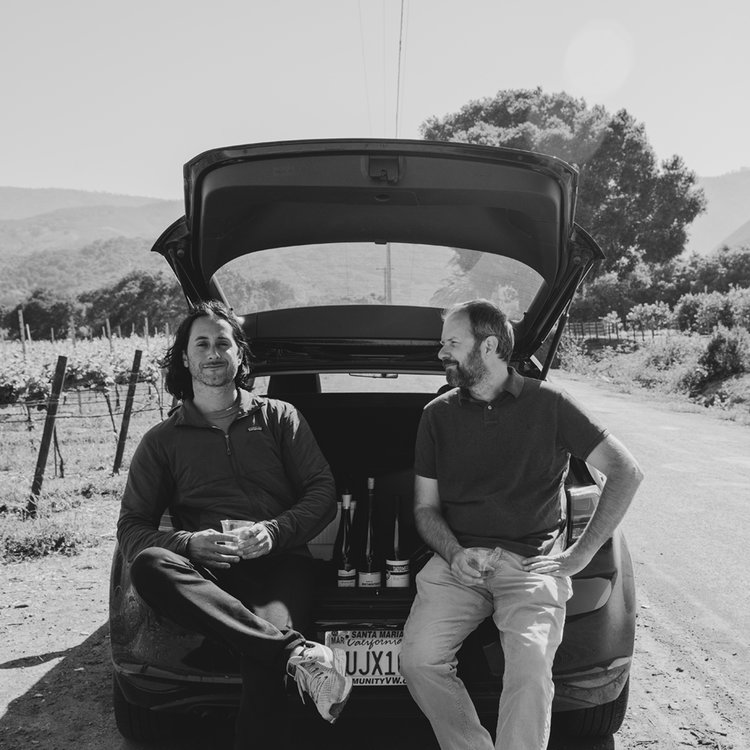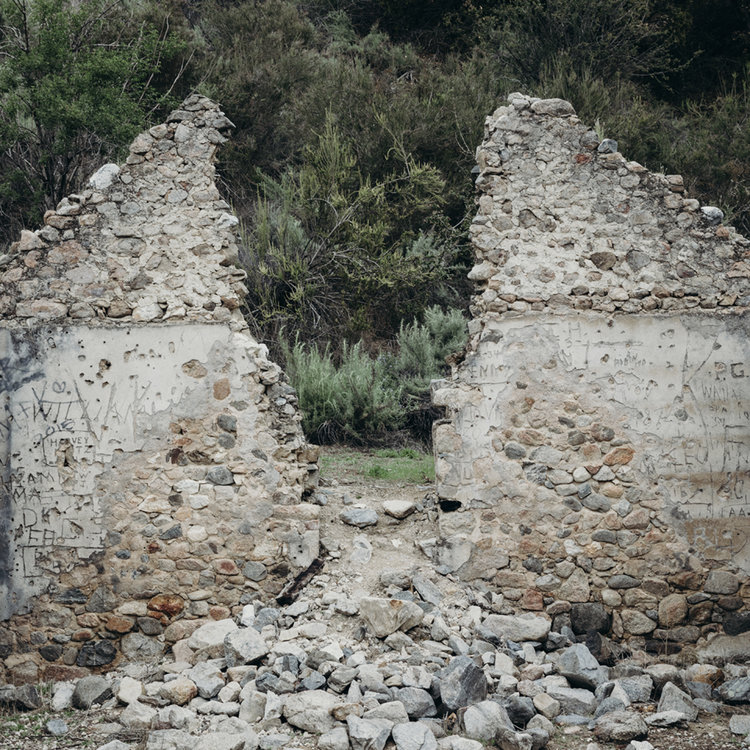east of eden
California may just be the easiest place on earth to make wine. It may also be the hardest. From top to bottom, coast to mountains, what other land is veritable Miracle-Gro for just about anything? Let the free association with any edible plant begin: avocados, peaches, apples, lemons, tomatoes, asparagus, savoy cabbage, purple cauliflower, rainbow chard and year-round sunflower sprouts. You want to namedrop produce? The Golden State is your Tinseltown. It’s no exception with wine grapes. We have everything from Albariño to Zinfandel, even a little Cab Pfeffer. Yet for all its agricultural endowments, what other region but California combines so potently an in-demand wine industry with cherished real estate. When you pay for prime vineyard land, you pay double for quality of life. And therein lies an ever-escalating economic dilemma: What is a young California winemaker to do in 2018?
GRAHAM TATOMER IN THE TAILGATE SCENARIO. RYAN STIRM WITH MAD POST-GRUNGE FLANNEL GAME
PRELUDE TO TATOMER AND STIRM
“It's no surprise that most of the interesting new wines are coming, honestly, from where they used to”, posits New California author Jon Bonné, “…from assistant winemakers who apprentice their way up, and eventually get to make some wine on their own. I take that as a hopeful sign, though. The best wines are always made through sweat equity.”
Two such ‘sweatees’ are Graham Tatomer of Tatomer Wines and Ryan Stirm of Stirm Wine Co. Both California natives, both strangers to blue-blooded beginnings, Graham and Ryan are having to machete their own unique path through the dry brush, testing their creative limits in the cellar and the vineyard, to secure any hope of future prosperity...
GRAHAM AND I TALK LIFE OVER AL PASTOR TACOS IN MONTEREY COUNTY
CELLAR WARS: GRAHAM TATOMER
It’s good to be a multi-generational French vigneron. A few hectares of mortgage-free estate vineyards; subterranean caves with private biomes of flora and fauna, clinging to ancient medieval walls, often a few cobblestone kilometers from the nearest neighboring winery. Comparatively, California feels like a post-apocalyptic turf war. And while there has always been an element of Senpai-Kohai mentorship harbored by the trade, according to Graham, the need to find a sponsor in the current market takes on new meaning. “I don’t know how anyone does it today without finding someone whose equipment you can use... From where I started Tatomer in 2008, my first complete vintage, where I didn’t have another full-time job on the side, was 2016.” The transition meant Graham could no longer squat on floor space provided by the Santa Barbara County wineries that once employed him: Melville / Brewer Clifton. He chuckles, “When times were tight growing up, we ate a lot of oatmeal and top ramen. I found myself in the early years of the winery going right back there again.”
It’s nothing new. Graham is the first to admit just how capital intensive it is for any California winemaker starting out. His mentor, Greg Brewer, faced a similar road. And nonetheless for Ryan’s mentor, Justin Willett of Tyler Winery. Even the godfathers of Santa Barbara County, Adam Tolmac, Jim Clendeden and Bob Lindquist broke bread in the same winery for years, the latter two still sharing a facility.
Where the game has changed In California is in the efficacy of calling anything one’s own. The Golden State turns to Iron Pyrite charting median home prices on past the $525,000 marker. It’s no surprise California is public enemy #1 for first-time homebuyers. The price per square foot of real estate listings has increased 72% since December of 2014. And there is no refuge in the Cali rental market with proportionate percentage increases. Average monthly rent at the start of 2013 clocked in at $1942 compared to $2512 today. The arc of the patient mom-and-pop operation, looking to grind their way into ownership of a production space, or even a long-term lease, has been elongated dramatically over the last 5 years. When Seth Kunin teed up a slot for Graham at CCWS, a custom crush facility in Santa Maria, it was literally a collective sigh of relief. CCWS offered unbeatable rent through communal living in a vinous hostel for proletariat winemakers; picture a warehouse version of cubicles from Office Space. And yes, Graham is often needed to come in on Sundays…
RYAN AND I AT HIS WINERY IN WATSONVILLE...
CELLAR WARS: RYAN STIRM
For Ryan the California housing boom became his angel. “My wife and I, in 2013 when the Santa Barbara real estate market was still shaky, bought a tiny fixer upper with help from her parents. We worked on the house every weekend for 2 years, until we flipped it and used the cash to launch our respective businesses.”After a four-year stint at Tyler Winery, Ryan reclaimed his Bay Area roots and joined the communal ranks of Santa Cruz production, before recently signing a lease on his own facility down the road in Watsonville.
Should you ever find yourself among the remnant of Armageddon, Ryan is the companion you want along the trade route. Or, for a lighter analogy, he would be hard to kill off as a character on the ‘Walking Dead’. Part cage fighter, part MacGyver, there are few green-souled crusaders with the ingenuity to navigate what he calls ‘The Waterworld’ model. “What others consider junk, I use in production… I’ve always been comfortable fixing old things and when you’re staring down a $70,000 bill for a new bladder press, I’d rather refurbish a broken-down one for $2000.”
The fixer-upper mentality is as much an environmental consideration for Ryan, as it is a practical one. Wasting not extends beyond residential life, carrying through to the equipment he salvages, and the abandoned vineyards he helps resurrect…
FROM CELLAR WARS TO RURAL SPRAWL...
RURAL SPRAWL: RYAN STIRM
For what is often cited as a fairly new region, we tend to forget California is somewhat of an Atlantis. “It's always worth remembering that "new" varieties in California aren't necessarily ‘new’.”, writes Jon Bonne. “Grüner Veltliner and Trousseau were recorded in E.W. Hilgard's work in the 1880s…a lot of smart, adventurous people were thinking about California's full potential a long time ago.”
To be alive in late 19th-century California was to take part in a vibrant wine culture whose export market would become increasingly powerful worldwide. Roots were laid down from a wide swath of grape varieties, often co-planted and cultivated to become fortified wine; the fashion of the day that would reign supreme until 1968. In between was pure economic desolation. Before Prohibition, there were 713 bonded wineries in California. The state wouldn’t reach that number again until 1986; just in time to see many of these old vineyards erode into forgotten wastelands or putt-putt along in the occasional winery’s test-kitchen bottling. The rise of Cabernet and Napa’s coming out party had supplanted any ambitious avant-garde endeavors with grapes like Mourvedre from Cienega Valley or Carignane from Contra Costa. And while the recent ‘Alt-Cali’ movement, as Jon dubs it, is still decidedly a novelty, there are new passion projects today that are not only attempting to unearth just how serious some of these ‘weird’ grapes can be, but wineries are building brand infrastructure entirely around them and their firmly alternative environments.
So, to what do we owe the rise of rural sprawl in California? Is it the brave winemaker, stepping out of their comfort zone for the sake of the arts? Is it the industry professionals who have and are championing progressive ideals? Is it the adventurous consumer, burying 80’s and 90’s rhetoric – a time, as Jon points out, “when the industry voted against diversity and curiosity”? It is all these things. But ultimately, the mother of invention is necessity, and a bid on Cabernet fruit from the Napa elite today commands $20,000 - $50,000 a ton. As in urban centers, economic hardship for the underfunded and unestablished fuels the diaspora. It’s happening in rural Sonoma and Santa Barbara as well.
“My primary focus is Riesling”, states Ryan, “and there was no way I was going to find a competitive vineyard lease in Santa Barbara. The community there is already so developed.” A return home galvanized the creative outlet Stirm knows best: fixing old things. Santa Cruz and Monterey county are the Stonehenge of the Central Coast. Driving out to vineyards that Ryan works by hand, rows of ancient dry-farmed, own-rooted vines at the feet of abandoned limestone quarries, it’s a haunting portal to the past. But there was no sense of extinction sampling Stirm barrels of a red grape called Cabernet Pfeffer. From a section, thought to be co-planted in 1895 with a touch of Trousseau (et al.), the mysterious Cabernet Pfeffer was injected with life, sparking a quasi-pedantic DNA inquiry as yet to be revealed. Believed by some to be the equally mysterious French grape Mourtaou, what can be said with 100% certainty is that it had to be bottled. 18 months from vintage 2016, Ryan and I would assemble the final blend and put this custom cuvee together.
SECRET VINEYARDS AND THE CHERUBS THAT GUARD THEM...
RURAL SPRAWL: GRAHAM TATOMER
Graham had a 4-year head start on Ryan, which made his migration north more arthroscopic than reconstructive. The Tatomer facility still resides in Santa Barbara County, as do most of his grape contracts, but Graham has run out of rope in the Riesling department. To stall growth or find fruit elsewhere became the choice; made simple by ensuring his young children, Coleman and Heidi, have food on the table. “In Santa Barbara, if I want to make Pinot Noir, sure, there’s a hundred vineyards to choose from. But if I want make more Riesling, there are only a few and they’re all allocated now.” Thankfully, Tatomer Riesling is also allocated in the marketplace, a dialogue no one could have imagined a decade ago.
In 2006, after multiple seasons interning under Weingut Knoll in Austria’s Wachau region, Graham turned down an opportunity to remain there and work a parcel of Riesling that would one day be his, in lieu of entertaining an Austrian-inspired project on domestic soil. Could there have been a more masochistic platform in 2008 than launching Tatomer, squarely on the back of California Riesling? Graham laughs, “Riesling is such an underdog story in America but so revered worldwide. And America’s weird. We’re like, ‘Is it sweet?’, which a lot of it is, but not all of it…but America also likes sweet things, unless it happens to be called Riesling. It’s totally upside down.” Where Graham walked a lonely path with dry Riesling, others like Ryan, have now followed, telling their own tale with the grape. The growing legacy of Tatomer would prompt a chance email from a new biodynamic Riesling farmer in Santa Lucia Highlands. It took one visit for Graham to be smitten with a granite-laden parcel, roughly 30 minutes from Ryan’s Cab Pfeffer site.
The Riesling vineyard in question remains exactly that. A secret. For Graham, all whereabouts will be given on a need to know basis, not for purposes of marketing fodder, but to virtually secure enough quantity for his future. While mum is the word on geography, as to quality, this is the first California Riesling, for my palate, that transports me directly to Austria. Graham has stumbled upon something very special, and we wait in earnest for what dreams may come…
OLD CALIFORNIA, EAST OF EDEN...
GEN-Z CALIFORNIA
Ryan and Graham both see their first-generation businesses secured for the coming one. But as vintage 2018 rapidly approaches, I think about how California 2.0 will preserve its legacy. How many of these successful projects will last 2, 3, 4…15 generations like some of the great wineries of France? Which of the producers we worship today are now planning their exit strategy in light of increased economic pressure? The smart money would indicate more than the generation before them.
As to the one after, several doe-eyed winemakers will be pressing their first load of California grapes this year. What they are up against is even more monumental. Jon commiserates, “It's really tough. Fruit costs are going up, including, now, for the weird grapes and growing regions that used to provide a bargain. Labor is expensive. Winemaking is expensive.” For an industry largely dependent on a diminishing Mexican work force, Trump-era policies do little to stop the bleeding. Graham adds, “Marijuana coming in has been super challenging. They need the same industrial zone as we do, but they get a crop every 3 months and processing time is 1 month… They can just afford so much more, so industrial space in Caifornia is super, super tight.”
When asked when Graham expects to own his own vineyards he shrugs, “I don’t know. Maybe in 2028…”, exactly 20 years from vintage one. Ryan hopes for a quicker trajectory but is content to fix what is broken for time eternal. “I have no plans to plant on raw land. I like making good use out of what’s already there and that’s how I feel we need to adapt to climate change and in this business. It would, however, be nice to grab an acre or two with a home and a proper cellar that I can dig out of a hillside. But all that’s down the road…”
Both are quick to cast aside the doom and gloom of what are, in the grand scheme of things, good problems. A life of production is cash poor but culture rich. And every now and then, the idyllic back of the bottle image is spot on. “No one is buying a yacht any time soon”, assures Graham, “but if a winemaker can get past that initial cash-flow negative hump, the lifestyle, being able to drink great bottles and barbecue with friends in backyards, is worth every penny…”
GREEN LIVING...
FINAL THOUGHTS
Viticole’s custom Riesling bottling with Tatomer is called ‘Östlich von Eden’ which translates East of Eden. The name pays tribute to author John Steinbeck, whose childhood home in Salinas is not far from Graham’s Riesling parcel. East of Eden is a biblical reference to Cain – one could perhaps say the first victim of rural sprawl. The novel, as in many of Steinbeck’s works, penetrates the beauty of a pastoral existence, delving deeply into the human condition and some of the harsher realities of agrarian life in California. This blog is dedicated to his memory.
- Brian McClintic
A special thanks to Hardy Wallace for carting my spoiled butt all over Monterey County, and as always, to Viticole operative, Lauren Hamilton, for taking all these lovely photos...












